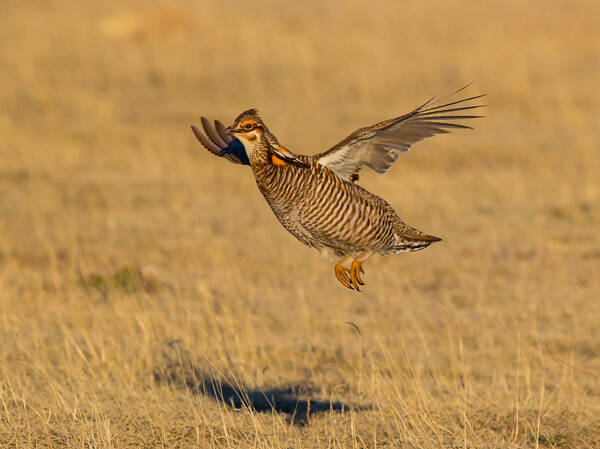Tympanuchus cupido
IUCN
LCBasic Information
Scientific classification
- name:Tympanuchus cupido
- Scientific Name:Tympanuchus cupido,Greater Prairie-chicken
- Outline:Landfowl
- Family:Gallinomorpha G.family P.Genus
Vital signs
- length:43-47cm
- Weight:900-1100g
- lifetime:About 5 years
Feature
The male bird has two pointed crowns on top of its head and large inflating yellow-orange air sacs above its neck and eyes
Distribution and Habitat
It is distributed in southern Canada and the Midwest of the United States. The Texas subspecies is limited to small areas in southeast Texas and neighboring southwestern Louisiana. Kansas, Nebraska and South Dakota have the most.
It inhabits the coniferous forest belt of larch, spruce, red pine and fir, generally at an altitude of 1500-2200 meters, with forest clearings of varying sizes. In the morning and evening, it is often active in the larger forest clearing, forest edge and sunny slope grass or brush, and other time it is active in the forest beside the fallen wood, shrubland or open space in the grass. It mainly roosts in larch trees at night. In winter, they often spend the night in a snow cave on the ground.
Appearance
The prairie grouse has a body length of 43-47 cm, a wingspan of 69 cm, and a weight of 900-1100 g. The two pointed crowns of needle-like feathers rising from the top of the male's head. Large, yellow-orange inflated air sacs above the neck and eyes. From the forehead to the top of the tail, the overlying feathers are yellow and dark brown moth or cloud spots. There are white spots on the abdomen. The tail is long and broad, with some white spots and a wide irregular white spot on the central tail feathers. The upper body of the female is rusty brown with black and yellowish markings, the lower body is lighter, the throat is yellowish or orange-yellow, the breast is brown, and the abdomen and flanks are pale white, densely covered with tan markings.
Both sexes have prominent feathers under the neck, but the male is longer. Sex can also be distinguished by the tail, which is short and square and dark brown in males and brown and tan in females. Other features of the species inclu
Details
The Prairie grouse (Tympanuchus cupido), also known as Greater Prairie-chicken, has three subspecies.

Prairie grouse usually live in a relatively small area of a few hundred acres to cover and meet their food and water needs. If food is in short supply, they can also fly several miles for food. It is usually active in the early morning and afternoon, and the food includes crops such as corn, soybeans and milo, as well as young leaves, seeds and insects. Chicks feed mainly on insects for the first few weeks of life.
During the breeding season, prairie grouse put on a colorful and beautiful show. Show-off shows are often performed in "bid-dances" or "arenas", in which many male birds participate together, called "bid-dances". In various ways, they first flap their pointy tail up and down, then puff out two yellow air bags on their chest, and put their head behind their neck in the forward vibration of their wings, forming a grotesque posture. The male grouse dances to the female with the sound of his feathers rubbing together and the sound of the cloth blowing out of the yellow balloon.

Prairie chickens hold this peculiar dance to show off. Before starting, the male grouse does a short run, then performs a fast tap dance, making a drumming sound. It raises its tail and flares up brightly colored air sacs on either side of its head. The grouse makes a strange, loud rumbling, and the air sacs gradually shrink, and then make a sound like the crow of a farm chicken. He jumps up at the same time, and as soon as he lands, he chases any male that comes near. Then the two males fought and struck each other with their wings.
Prairie grouse, abundant east of the Rocky Mountains in the mid-1920s, has been decimated and scattered. The named subspecies once lived along the eastern seaboard of the United States, but the last wild grouse died in 1932. Several factors have contributed to the decline in prairie grouse numbers, such as habitat loss and changes to their environment due to the spread of agriculture on grasslands. Prairie fires during breeding season, and overshooting.
Listed on the International Union for Conservation of Nature (IUCN) 2016 Red List of Threatened Species ver 3.1 - Vulnerable (VU).
Protect wild animals and eliminate wild meat.
Maintaining ecological balance is everyone's responsibility!








